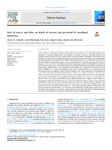Role of waves and tides on depth of closure and potential for headland bypassing
| dc.contributor.author | Valiente, NG | |
| dc.contributor.author | Masselink, Gerd | |
| dc.contributor.author | Scott, Tim | |
| dc.contributor.author | Conley, Daniel | |
| dc.contributor.author | McCarroll, Jak | |
| dc.date.accessioned | 2018-11-26T14:53:14Z | |
| dc.date.available | 2018-11-26T14:53:14Z | |
| dc.date.issued | 2019-01-01 | |
| dc.identifier.issn | 0025-3227 | |
| dc.identifier.issn | 1872-6151 | |
| dc.identifier.uri | http://hdl.handle.net/10026.1/12893 | |
| dc.description | No embargo required. | |
| dc.description.abstract |
© 2018 Depth of closure is a fundamental concept used to define the seaward extent of a morphodynamically active shoreface at a particular temporal scale. The estimation of this limit in relation to the depth in front of the bounding headlands along embayed coastlines allows questioning whether embayments, often deemed closed sediment cells, experience more headland bypassing than expected. Wave-based parameterisations developed for microtidal beaches are most widely used to estimate closure depth; however, a re-evaluation of the concept for shorefaces influenced by geological control (presence of headlands and/or bedrock) and strong tidal currents is appropriate. Here, we use the macrotidal, embayed and high-energy coastline of SW England to identify the ‘active’ nearshore limits with a multi-method approach that includes observations of shoreface morphology and sedimentology, offshore/inshore wave formulations and bed shear stress computations. We identify the basal limit of ‘significant’ (i.e., 0.14 m) morphological change (Depth of Closure; DoC) and a maximum depth of extreme bed activity and sediment transport (Depth of Transport; DoT). Observations of DoC correspond closely to the values predicted by existing formulations based on inshore wave conditions (10–15 m for the study area; relative to mean low water spring water level in this case). The computed DoT, represented by the upper-plane bed transition attained under extreme conditions, exceeds 30 m depth in the study area. The significant implication is that, even though many headlands appear sufficiently prominent to suggest a closed boundary between adjacent embayments, significant wave- and tide-driven sediment transport is likely to occur beyond the headland base during extreme events, especially at low water levels. The maximum depth for significant sediment transport (DoT) was computed across a broad wave-current parameter space, further highlighting that tidal currents can increase this closure depth estimate by ~10 m along macrotidal coastlines, representing a 30% increase compared to tideless settings. This work illustrates the importance of tidal currents in depth of closure calculations and challenges the notion that embayed beaches are generally closed cells, as headland bypassing may be more wide spread than commonly assumed along exposed coastlines globally. | |
| dc.format.extent | 60-75 | |
| dc.language | en | |
| dc.language.iso | en | |
| dc.publisher | Elsevier | |
| dc.subject | Nearshore sediment transport | |
| dc.subject | Bed shear stress | |
| dc.subject | Depth of closure | |
| dc.subject | Headland bypassing | |
| dc.subject | Macrotidal | |
| dc.subject | Embayments | |
| dc.title | Role of waves and tides on depth of closure and potential for headland bypassing | |
| dc.type | journal-article | |
| dc.type | Journal Article | |
| plymouth.author-url | https://www.webofscience.com/api/gateway?GWVersion=2&SrcApp=PARTNER_APP&SrcAuth=LinksAMR&KeyUT=WOS:000456222900005&DestLinkType=FullRecord&DestApp=ALL_WOS&UsrCustomerID=11bb513d99f797142bcfeffcc58ea008 | |
| plymouth.volume | 407 | |
| plymouth.publication-status | Published | |
| plymouth.journal | Marine Geology | |
| dc.identifier.doi | 10.1016/j.margeo.2018.10.009 | |
| plymouth.organisational-group | /Plymouth | |
| plymouth.organisational-group | /Plymouth/Faculty of Science and Engineering | |
| plymouth.organisational-group | /Plymouth/Faculty of Science and Engineering/School of Biological and Marine Sciences | |
| plymouth.organisational-group | /Plymouth/PRIMaRE Publications | |
| plymouth.organisational-group | /Plymouth/REF 2021 Researchers by UoA | |
| plymouth.organisational-group | /Plymouth/REF 2021 Researchers by UoA/UoA07 Earth Systems and Environmental Sciences | |
| plymouth.organisational-group | /Plymouth/Research Groups | |
| plymouth.organisational-group | /Plymouth/Research Groups/Marine Institute | |
| plymouth.organisational-group | /Plymouth/Users by role | |
| plymouth.organisational-group | /Plymouth/Users by role/Academics | |
| plymouth.organisational-group | /Plymouth/Users by role/Researchers in ResearchFish submission | |
| dcterms.dateAccepted | 2018-10-22 | |
| dc.rights.embargodate | 2019-11-27 | |
| dc.identifier.eissn | 1872-6151 | |
| dc.rights.embargoperiod | Not known | |
| rioxxterms.versionofrecord | 10.1016/j.margeo.2018.10.009 | |
| rioxxterms.licenseref.uri | http://www.rioxx.net/licenses/all-rights-reserved | |
| rioxxterms.licenseref.startdate | 2019-01-01 | |
| rioxxterms.type | Journal Article/Review | |
| plymouth.funder | Physical and biological dynamic coastal processes and their role in coastal recovery (BLUE-coast)::NERC | |
| plymouth.funder | Physical and biological dynamic coastal processes and their role in coastal recovery (BLUE-coast)::NERC | |
| plymouth.funder | Physical and biological dynamic coastal processes and their role in coastal recovery (BLUE-coast)::NERC |


